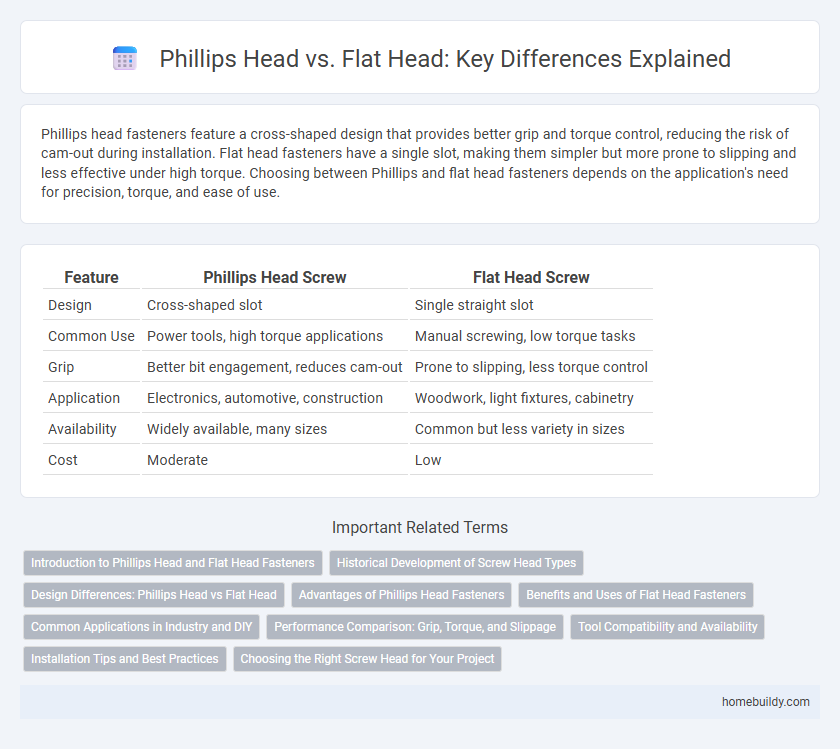Phillips head fasteners feature a cross-shaped design that provides better grip and torque control, reducing the risk of cam-out during installation. Flat head fasteners have a single slot, making them simpler but more prone to slipping and less effective under high torque. Choosing between Phillips and flat head fasteners depends on the application's need for precision, torque, and ease of use.
Table of Comparison
| Feature | Phillips Head Screw | Flat Head Screw |
|---|---|---|
| Design | Cross-shaped slot | Single straight slot |
| Common Use | Power tools, high torque applications | Manual screwing, low torque tasks |
| Grip | Better bit engagement, reduces cam-out | Prone to slipping, less torque control |
| Application | Electronics, automotive, construction | Woodwork, light fixtures, cabinetry |
| Availability | Widely available, many sizes | Common but less variety in sizes |
| Cost | Moderate | Low |
Introduction to Phillips Head and Flat Head Fasteners
Phillips head fasteners feature a cross-shaped slot designed for improved grip and torque control with screwdrivers, enhancing efficiency in assembly applications. Flat head fasteners have a simple, single-slot design and a countersunk shape that allows the screw to sit flush with the surface, providing a smooth finish. Both types serve distinct purposes in mechanical fastening, with Phillips heads preferred for power tools and flat heads used for aesthetic or flush installations.
Historical Development of Screw Head Types
The historical development of screw head types reveals that the Phillips head was designed in the 1930s to provide better torque control and reduce cam-out, improving efficiency in industrial assembly lines. In contrast, the flat head screw predates Phillips, originating in the 18th century with simple slot designs that allowed manual tightening but often suffered from slippage and limited torque application. The transition from flat head to Phillips marked a significant advancement in fastening technology, enhancing usability in mass production and automotive industries.
Design Differences: Phillips Head vs Flat Head
Phillips head fasteners feature a cross-shaped recess designed to center the screwdriver and reduce cam-out, allowing for greater torque application compared to flat head fasteners. Flat head fasteners have a single straight slot, which offers simpler designs but requires more precision to avoid slippage during installation. The Phillips design improves alignment and efficiency in automated assembly processes, whereas flat head screws are often preferred for applications needing manual, controlled torque.
Advantages of Phillips Head Fasteners
Phillips head fasteners provide superior torque control and reduce the risk of cam-out, making them ideal for automated assembly processes. Their cross-shaped design enables better alignment with the screwdriver, increasing efficiency and reducing slippage. These advantages contribute to improved fastening reliability and faster installation in various industrial applications.
Benefits and Uses of Flat Head Fasteners
Flat head fasteners provide a flush, smooth surface when installed, making them ideal for applications requiring a clean finish and reduced snagging, such as cabinetry and furniture assembly. Their countersunk design distributes load evenly, enhancing structural integrity and reducing material stress in wood, metal, and plastic joints. Widely used in aerospace and automotive industries, flat head fasteners ensure aerodynamic surfaces and precise component alignment.
Common Applications in Industry and DIY
Phillips head fasteners are widely used in automotive assembly and electronics due to their self-centering design, which reduces cam-out and allows for higher torque applications. Flat head screws are preferred in woodworking and furniture making, providing a flush finish that enhances aesthetic appeal and reduces snag points. Both types find extensive use in DIY projects, with Phillips heads favored for power tools and flat heads for manual applications requiring precise surface alignment.
Performance Comparison: Grip, Torque, and Slippage
Phillips head fasteners provide superior torque application due to their cross-shaped design, which allows the screwdriver to center itself and reduce cam-out during tightening. Flat head fasteners, with a single slot, often struggle with grip and are more prone to slippage under high torque, compromising fastening reliability. When comparing grip and torque efficiency, Phillips heads outperform flat heads in maintaining secure engagement and minimizing tool wear.
Tool Compatibility and Availability
Phillips head screws are widely compatible with standard Phillips screwdrivers and are commonly available in various sizes, making them a versatile choice for many applications. Flat head screws require a flat-blade screwdriver, which is less specialized but can slip easily under torque, affecting tool performance. Both types are readily available, but Phillips head fasteners tend to be more prevalent in modern construction and manufacturing due to better tool compatibility.
Installation Tips and Best Practices
Phillips head fasteners require applying consistent torque with a properly sized screwdriver to prevent cam-out and damage to the screw. Flat head screws demand careful alignment of the driver blade to avoid slipping and stripping, especially in softer materials like wood or plastic. For both types, using high-quality tools and maintaining clean, debris-free screw heads ensures efficient installation and prolonged fastener life.
Choosing the Right Screw Head for Your Project
Choosing the right screw head significantly impacts the durability and ease of installation in fastener projects. Phillips head screws provide superior torque control and are designed to prevent cam-out, making them ideal for power tools and precision applications. Flat head screws offer a flush finish, ideal for woodworking and applications requiring a smooth surface, emphasizing aesthetic appeal and structural integrity.
Phillips Head vs Flat Head Infographic

 homebuildy.com
homebuildy.com